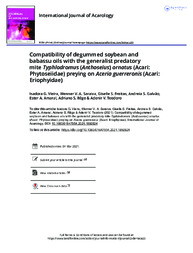Compatibility of degummed soybean and babassu oils with the generalist predatory mite Typhlodromus (Anthoseius) ornatus (Acari: Phytoseiidae) preying on Aceria guerreronis (Acari: Eriophyidae).
Compatibility of degummed soybean and babassu oils with the generalist predatory mite Typhlodromus (Anthoseius) ornatus (Acari: Phytoseiidae) preying on Aceria guerreronis (Acari: Eriophyidae).
Author(s): VIEIRA, I G.; SARAIVA, W. V. A.; FREITAS, G. S.; GALVAO, A. S.; AMARAL, E. A.; REGO, A. S.; TEODORO, A. V.
Summary: Typhlodromus (Anthoseius) ornatus Denmark & Muma (Acari: Phytoseiidae) is one of the predatory mites associated with the coconut mite Aceria guerreronis (Acari: Eriophyidae), considered a severe pest of coconut plantations worldwide. In addition to predatory mites, vegetable oils such as degummed soybean and babassu oils have shown high efficiency in controlling A. guerreronis. Here, we evaluated the effects of degummed soybean and babassu oils on the functional response and oviposition of T. (A.) ornatus preying on A. guerreronis. Exposure to the tested oils did not alter either the functional response or the attack rate of T. (A.) ornatus. The variation in prey consumption with the exposure to vegetable oils did not differ from the control, although degummed soybean oil led to higher consumption compared to babassu oil. In addition, prey handling time and peak consumption were negatively affected by the exposure to babassu oil. The number of eggs laid by the female of T. (A.) ornatus at intermediate prey density decreased under exposure to degummed soybean oil. Overall, our results indicate that the tested oils are generally compatible with T. (A.) ornatus as they do not alter predatory responses but oviposition rate is affected by degummed soybean
Publication year: 2021
Types of publication: Journal article
Observation
Some of Embrapa's publications are published as ePub files. To read them, use or download one of the following free software options to your computer or mobile device. Android: Google Play Books; IOS: iBooks; Windows and Linux: Calibre.
Access other publications
Access the Agricultural Research Database (BDPA) to consult Embrapa's full library collection and records.
Visit Embrapa Bookstore to purchase books and other publications sold by Embrapa.

